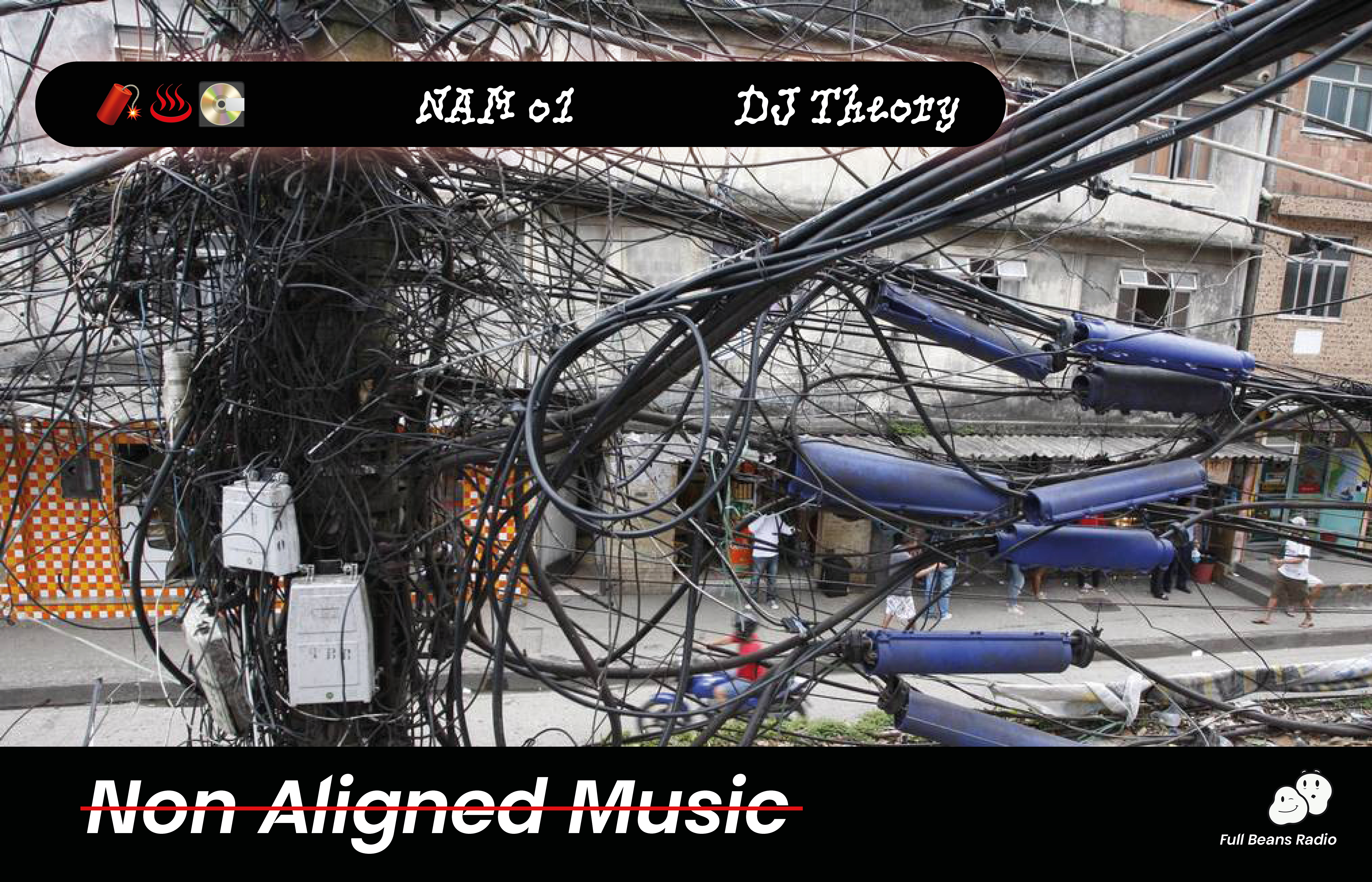
13.07.25
NAM01 /w DJ Theory
NAM is a new show on Full Beans Radio, exploring non-alignment in experimental and electronic music. The series will unfold as an open-ended research in dialogue with and in the presence of others, collectively exploring different non-aligned sonorities.
The show echoes the efforts of the Non-Aligned Movement, which has its origins in the Bandung Conference in 1955, the first large-scale Afro-Asian conference held up to that point. The movement was formally established with the first Non-Aligned Summit in 1961 in Belgrade/Yugoslavia, initiated by state leaders of Yugoslavia, India, Ghana, Indonesia, and the United Arab Republic. Its core aim was to establish a transnational alliance between countries, mainly of the Global South, which didn’t see their interests represented in Western capitalism or Soviet communism. This refusal to align with any of the major power blocs, West vs. East, was articulated in a series of principles first formulated in Bandung: a collective commitment to anti-colonialism and anti-racism, state sovereignty and independence, peace and disarmament, global socio-economic justice, and mutual benefit in multilateral cooperation. (1) The Bandung principles propose a progressive internationalist agenda and call for transnational solidarity among the peoples of the Majority World. The movement was a driving force for decolonisation in the postwar era and a loud advocate for the liberation of occupied territories, as well as for the end of Apartheid in South Africa.
Curator and researcher Nataša Vukajlović, a friend I met last year during her artist residency at Akademie Schloss Solitude in Stuttgart, introduced me to Yu-Mex, a non-aligned music genre she was researching at the time. Yu-Mex became popular in Yugoslavia during the 1950s and 1960s, precisely during the time the Non-Aligned Movement was gaining traction. The country didn’t have much of a film industry during the immediate post-war period. After the Tito-Stalin Split, President Tito didn’t want to screen films from the Soviet Union, but also didn’t want to import films from the US. Yugoslavia started importing films from Mexico, which inspired local musicians to produce Yu-Mex, a blend of Mexican folk music with Yugo lyrics. (2) Here, non-aligned music emerges from the refusal to consume, absorb, or reproduce ideologies that ultimately serve the ruling system and exploit its margins. It is conscious of the means of cultural production and embraces the unpredictable, chaotic processes of creative digestion and cannibalisation as a way to transition into new networks of resistance.
The first episode of NAM: Non-Aligned Music explores a militant and syncopated groove in forward motion that unites sonic communities across different geographies and temporalities. Think of anti-war activists spitting their poetry on a bulldozing beat that screams destruction in Bengali, Gastarbeiter-Bass from Germany conspiring an underground movement in Libya, pre-Hispanic sound technologies and dembow deviations blasting over the streets of Mexico City, all coming together to ”Sonically Dismantle Western Imperialism“ (3). A DJ mix here becomes a tactic to rehearse a globally connected and layered collectivity without the need for complete assimilation: The temporary alignment of two distinct tracks allows for different sonic entities to build a flow, and to transition from one collectivity to another while maintaining each other’s integrity. This mode of cultural cooperation allows for partial alignment and values multiplicity in order to build momentum. It catalyses the affective qualities of sound, its capacity to move people and energetically charge a space, to attune others to psychologically, emotionally, or geographically distant localities.
I was searching for a rhythmic structure that is in itself non-aligned to start the mix with. A Non-Aligned Movement not only refuses complicity with power but also needs to hold space for non-alignment and frictions within itself. If a community formed of non-aligned individuals had a riddim to march with, for me, I-LP-O in Dub’s disintegrating dub would come close to embodying the dislocated, at times out-of-sync, groove of their collective body. Under this more recent moniker, Ilpo Väisänen released two albums, Communist Dub and Capital Dub Chapter 1, both resounding failures and atrocities emergent from the Western and Eastern political systems (4, 5). The style and narrative of both albums invoke a sense of disorientation and delusion, defined by reverb-drenched and decaying loops, evocative of self-destructive systems stuck in their compulsion for self-preservation. Nevertheless, the more optimistic side of me would like to propose being moved by these sonorities differently. This sound invites us to stay present with the complexity of an increasingly chaotic world, and not to fall in line with either capitalist progressive ideology or communist nostalgia. Instead, it urges us to use our collective imagination and to come up with another way, one that resonates with social justice, mutual respect, multiplicity, and non-alignment.
Sources
- Non-Aligned Movement (n.d.) Bandung Principles. Available at: nam.go.ug/bandung-principles (Accessed: 8 July 2025).
- Miha Mazzini (2013) YuMex – Yugoslav Mexico. Available at: youtube.com/watch?v=oL33I39nlV0&t=1296s (Accessed: 8 July 2025).
- Badawi (2024) Sonically Dismantling Western Imperialism. Available at: badawidub.bandcamp.com/album/sonically-dismantling-western-imperialism (Accessed: 8 July 2025).
- I-LP-O in Dub (2015) Communist Dub. Available at: ilpovaeisaenen.bandcamp.com/album/communist-dub (Accessed: 8 July 2025).
- I-LP-O in Dub (2017) Capital Dub Chapter 1. Available at: ilpovaeisaenen.bandcamp.com/album/capital-dub-chapter-1 (Accessed: 8 July 2025). </small>
Links
Graphics
- Image: Hora Campinas
- Fonts: BBB Poppin TN & PicNic, licensed via Typothèque Bye Bye Binary Donate here: typotheque.genderfluid.space
